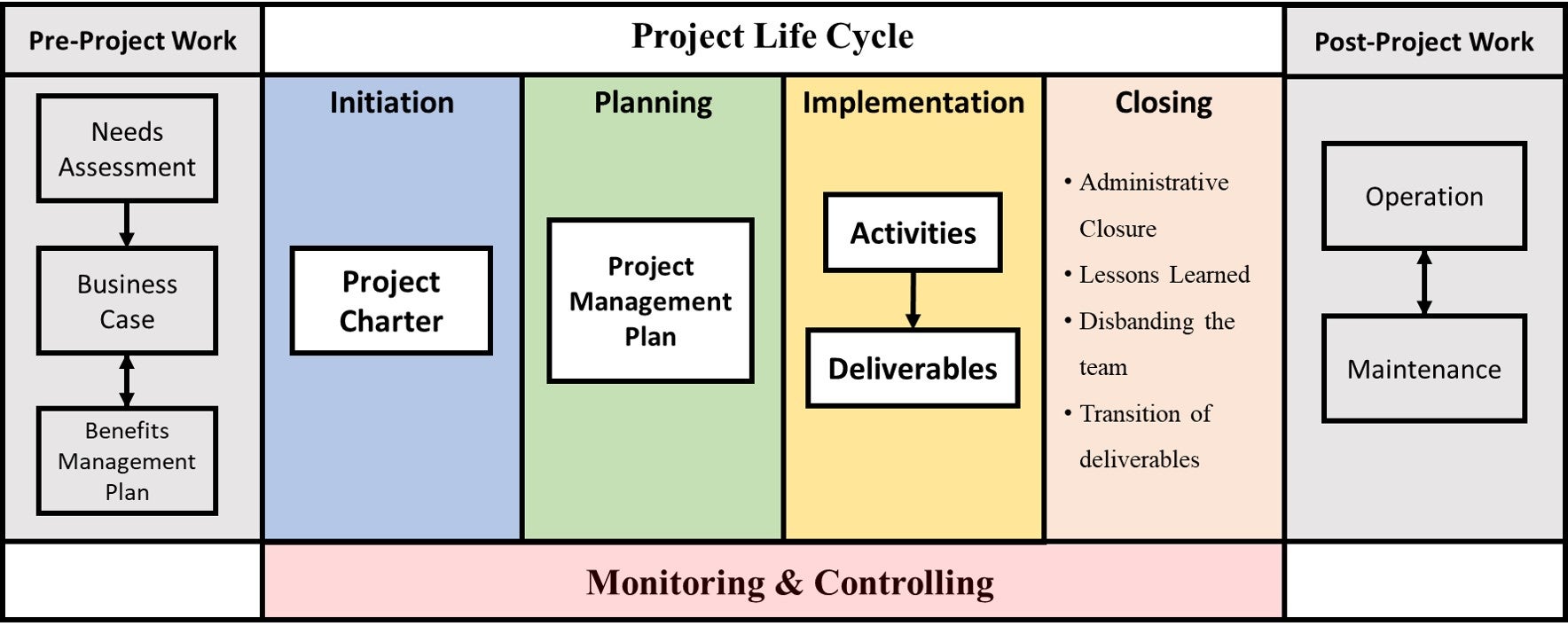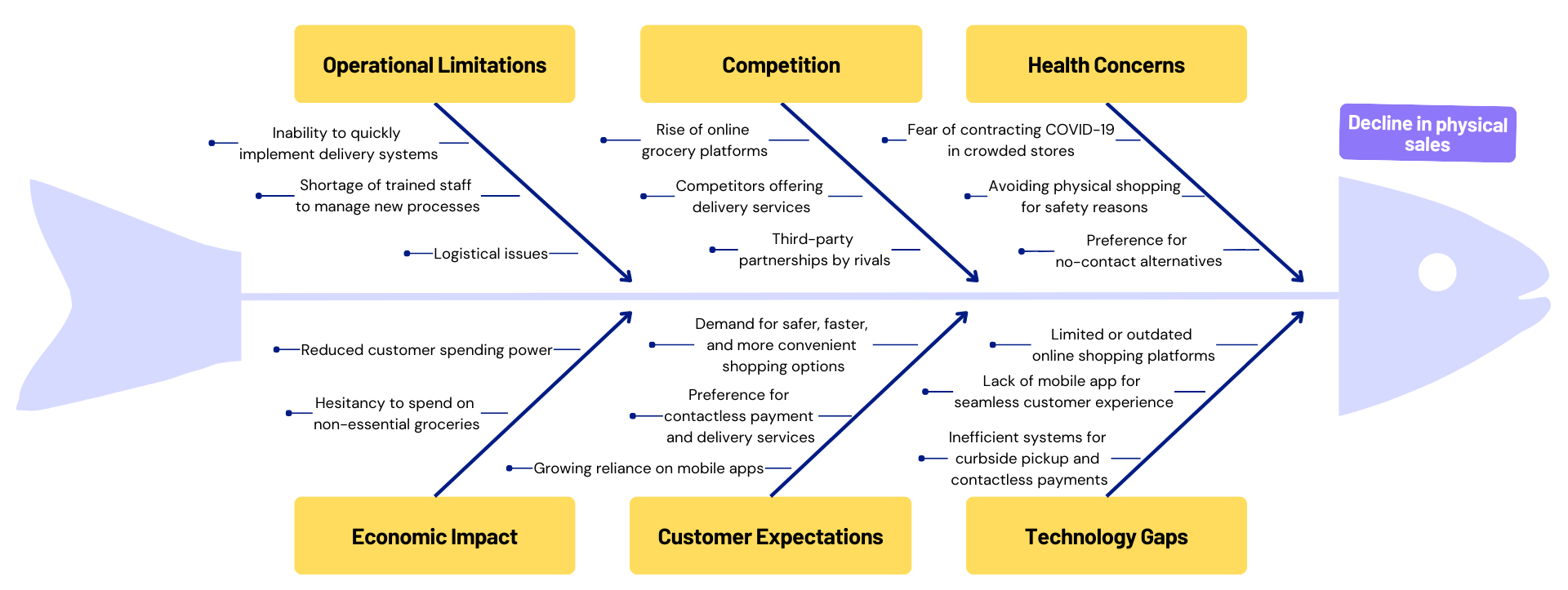Chapter 2. Strategy, Objectives, and Project Selection
2.3 Business Case
Organizations initiate projects to exploit business opportunities aligned with their strategic goals or eliminate business problems they encounter[1]. Projects are generally preceded by a business case that provides the economic, financial, and/or social feasibility and justification of the business need (Figure 2.3.1). However, some projects may be initiated in a short time with an order from the CEO or executive management team to address competitive measures, government mandates, or an exclusive inclination[2]. Hence, there may not be a formal business case that the project team can utilize to initiate the project. Nevertheless, in such situations, project managers are generally asked to conduct a needs assessment and feasibility study as well as a benefits management plan. Business cases aim to respond to a need, generally in the form of a problem or an opportunity, and they are generally prepared by business analysts in an organization in collaboration with relevant units and stakeholders.
A business case attempts to elaborate on the need for a project by providing an analysis of the current state, a description of the desired future state, and the actions to take to fill the gap between the current state and the desired future state. It also includes business, stakeholder, solution, and transition requirements, designs and recommended solutions generated according to these requirements, and the evaluation of solutions to understand the potential value of these solutions[3]. A business case is accompanied by a needs assessment and benefits realization management plan. A needs assessment often precedes the business case, and it is used to assess the current internal and external environments and current capabilities of the organization to determine the viable solution options that, when pursued, would help the organization meet the desired future state[4].

Compiled from: PMBOK Guide 6th Edition
The value of a business case to the project is two-fold. First, it is used as an input in the development of a project charter during the initiation (starting, conceptualization) project life cycle stage. Additionally, it is utilized as input to identify stakeholders who may be affected by or may affect decisions, activities, or outcomes of a project[5]. Therefore, business cases are utilized as a basis for authorization of further project management activities.
A business case can also be described as an economic feasibility study documented to justify and establish boundaries for the project. The validity of benefits is established through two accompanying processes: business needs analysis and cost-benefit analysis. Therefore, the required investment to start a project to acquire the expected outcomes can be justified from a business standpoint.
While many business cases share common elements, each one is tailored to the organization in which it is used. A business case can be formatted based on the needs of the organization and/or the organization’s templates in its knowledge repository. The main components of a business generally consist of:
- Need statement (Underlying problems or opportunities)
- The cause-effect, fishbone, or Ishiwaka diagram is a useful instrument in this stage to identify the underlying issues rather than describe the surface-level issues.
- If it is an opportunity, the main contributors are investigated.
- Statement of goals (Business requirements)
- Stakeholders and their requirements
- Analysis of current state and future state, and creation of a business change strategy
- Constraints, dependencies, assumptions, risks, critical success factors, and decision criteria
- Designs and alternative solutions
- Potential value (benefits and costs)
Business Case for Grocery LLC’s M-Commerce Project
Background:
Grocery LLC’s physical sales have declined worldwide since the onset of the COVID-19 pandemic. Customers prefer buying online instead of visiting a store in person since they are concerned about contracting COVID-19. Our fifty stores in five states lost around 30% of regular customers, and the revenue declined by 25% since the start of the pandemic restrictions in March 2020.
The current situation demands an innovative response to changing customer behavior and market conditions to recover lost revenue and sustain long-term growth.
1. Need Statement (Underlying Problems or Opportunities)
The core business problem Grocery LLC faces is declining physical sales due to shifts in customer behavior. While this decline presents a challenge, it also creates an opportunity for the business to adapt and innovate.
- Underlying Issues (Fishbone Diagram):

2. Statement of Goals (Business Requirements)
To address the challenges, Grocery LLC aims to:
-
- Recover lost revenue and regain market competitiveness.
- Enhance customer engagement by providing flexible shopping options.
- Ensure a safer shopping environment for all customers.
Measurable Goals:
-
- Recover 25% of lost revenue within 12 months.
- Retain 90% of existing customers through improved services and experiences.
- Increase online sales by 30% through digital initiatives.
3. Stakeholders and Their Requirements
- Customers: Convenience, safety, and fast access to products.
- Store Managers: Logistical feasibility for curbside pickup, deliveries, and in-store kiosk integration.
- Employees: Adequate training to manage new services (e.g., deliveries, meal kits).
- Third-Party Platforms: Clear partnership terms for grocery delivery services.
- Delivery Partners: Efficient communication systems and streamlined logistics for timely deliveries.
4. Analysis of Current State and Future State, and Business Change Strategy
- Current State:
- Limited online presence and outdated shopping systems.
- Customers are migrating to competitors that offer delivery and curbside options.
- Future State:
- Fully integrated online platform and physical stores.
- Seamless customer experience through digital solutions, curbside pickup, delivery options, mobile app, and optimized mobile website.
- Business Change Strategy:
-
- Implement delivery services and curbside pickup as immediate solutions.
- Optimize the website and launch a mobile app for online orders.
- Introduce contactless payment systems and in-store kiosks to enhance safety.
- Expand digital marketing to reach customers through targeted campaigns and social media.
5. Constraints, Dependencies, Assumptions, Risks, Critical Success Factors, and Decision Criteria
Constraints:
-
- Budget limitations for technology upgrades and marketing.
- Reliance on third-party platforms for delivery services.
Assumptions:
-
- Customers will adopt new services if marketed effectively.
- Technology solutions can be implemented within the proposed timeline.
Risks and Mitigation Strategies:
-
- High operational costs for delivery services: Start with partnerships to reduce upfront investment.
- Customer resistance to new systems: Offer incentives and education campaigns to encourage adoption.
- Employee training delays: Provide comprehensive training programs with ongoing support.
Critical Success Factors:
-
- Customer satisfaction and adoption rates.
- Revenue recovery and sustained growth.
- Seamless implementation of technology and partnerships.
Decision Criteria:
-
- Cost-effectiveness of the solution.
- Positive impact on revenue and customer retention.
- Alignment with Grocery LLC’s strategic goals.
6. Designs and Alternative Solutions
Primary Solutions:
-
- Curbside Pickup System: Develop a scheduling system for order pickups, integrating it into the website and app.
- Delivery Partnerships: Leverage third-party platforms to handle logistics and deliveries efficiently.
- Mobile App and Optimized Website: Ensure a user-friendly platform for ordering and managing customer engagement.
- Contactless Payment: Introduce NFC-based payments and self-checkout kiosks in all stores.
Alternative Solutions:
-
- If delivery partnerships prove too costly, prioritize curbside pickup as a low-cost alternative.
- If app development is delayed, improve the existing website with added functionality for ordering.
7. Potential Value (Benefits and Costs)
- Benefits:
-
- Increased Revenue: Recover 25% of lost revenue within a year.
- Customer Retention: Retain 90% of existing customers through enhanced convenience.
- Competitive Advantage: Meet evolving customer expectations and regain market position.
- Cost Estimates:
| Solution | Estimated Cost | Potential Benefit |
| Curbside Pickup | $50,000 for software | Increased customer satisfaction and loyalty. |
| Delivery Service Partnerships | $75,000 annually | Increased reach and incremental sales. |
| Mobile App and Optimized Website | $100,000 development | Enhanced m-commerce presence and customer satisfaction. |
| Contactless Payments/Kiosks | $100,000 upfront | Improved in-store experience and safety. |
| Digital Marketing Campaign | $25,000 per quarter | Increased online engagement and store visits. |
Although the preparation of a business case and its accompanying documents are considered pre-project work, project managers may also be involved in this process, in particular if a PMO (Project Management Office) exists in an organization or the project initiation is requested from the top level or if it is an urgent request from a client.
Project managers or project steering committees use the information available in a business case to initiate the project, identify stakeholders, and develop a project charter. A business case helps create performance metrics that measure the project’s success against the objectives whenever a deliverable is produced, and the project outcomes are generated at the end of the project.
Business cases play an essential role during project selection. Project selection committees or senior managers assess all the business cases and their recommended solutions as candidate projects. Due to various factors such as time, budget and resource constraints, internal and external factors, and organizational strategic priorities and plans, organizations cannot implement all the projects. The next section discusses the project selection criteria.
- Project Management Institute. (2017). A guide to the Project Management Body of Knowledge (PMBOK guide) (6th ed.). Project Management Institute. ↵
- Project Management Institute. (2015). Business analysis for practitioners: A practice guide. ↵
- International Institute of Business Analysis. (2015). A guide to the Business Analysis Body of Knowledge (BABOK Guide), version 3.0. Toronto, Ont: International Institute of Business Analysis. ↵
- Project Management Institute. (2015). Business analysis for practitioners: A practice guide ↵
- Project Management Institute. (2017). A guide to the Project Management Body of Knowledge (PMBOK guide) (6th ed.). Project Management Institute. ↵

